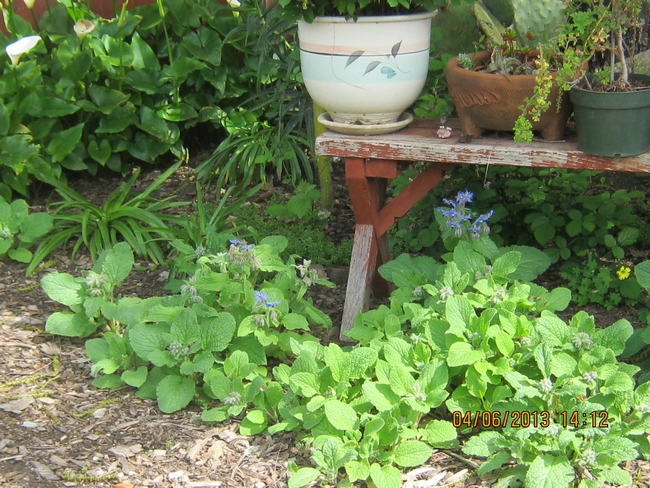Borage: Bee Bread
Borage (Borago officinalis), aka starflower, bee bread. Clusters of sky blue, nectar-rich starflowers grace this Mediterranean annual herb almost continuously through Spring, Summer and Fall. Honey bees and bumble bees can't get enough of it. It has distinguishing black anthers, white prickly hairs and bristly stems and leaves. It is often grown as a companion plant to legumes, strawberries, spinach and brassicas. Full sun, any soil, keeps this plant growing 2-3 feet tall. Keep it dry or provide very moderate water. It reliably reseeds itself year after year.
I placed just one plant in my hard-clay soil a couple years ago. Now, single stems emerge in new spots every Spring. So, be sure you don't mind it popping up just about anywhere it pleases. If you have a small hill or bare area, an empty corner, if you like your garden a little more wild or informal, you will love the bees that head directly to the borage; they will then frequent your garden to explore your other goodies.
Since ancient times, borage has been regarded as having a wonderful effect on mind and body. When the yard is alive with sky blue color and pollinators, it certainly lightens the heart and calms the mind. Great-grandmother's pillowcases may have borne the embroidered likeness of borage. Borage oil is said to have an anti-inflammatory, skin-healing effect and is used in skin products to restore moisture and smoothness. The flowers are edible and, when separated from their calyxes, the corollas can be floated in cold drinks like maraschino cherries or used to garnish salads.
The tender young leaves (which lose their flavor when dried) have a cucumber-like taste and aroma and can be used in salads, herb vinegars and pickling. Its leaves are sometimes used as coolants in drinks and were once widely used as an addition to tankards of wine and cider. They’re still commonly included in recipes for claret cup, a drink that consists of iced claret and a little brandy seasoned with sugar, sliced lemon and the herb leaves. It is suspected that the leaves of borage, steeped in wine, were the mysterious Nepenthe elixir that Homer writes about. Roman historian, Pliny, praised Nepenthe for its ability to drive away melancholy and bring pleasant forgetfulness.
At Mendocino Coast Botanical Gardens in Fort Bragg (http://www.gardenbythesea.org/), not only are there spectacular views of the ocean, there are bees are foraging on the Borage that borders the vegetable gardens. At Luther Burbank's Gold Ridge Experiment Farm in Sebastopol (http://www.wschsgrf.org/luther-burbank-gold-ridge-experiment-farm), it's a sea of Borage.
Check out these bee photos by Kathy Keatley Garvey on UC California Garden Web. Wow! She is awesome.
http://ucanr.edu/sites/gardenweb/?blogstart=7&blogtag=yellow-faced%20bumble%20bee&blogasset=42184
NOTE: The UC Gardeners do not recommend consuming any plant unless you have it identified as edible.

Star-shaped flowers turn pink as they age. (photos by Susan Croissant)

Honey bee on borage.

Borage just beginning to pub on flowers.
Posted by Donna Seslar on October 13, 2013 at 6:43 PM